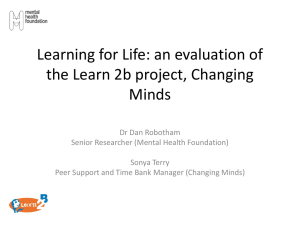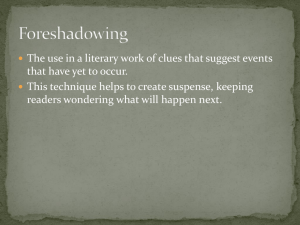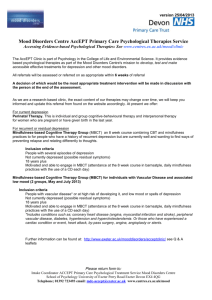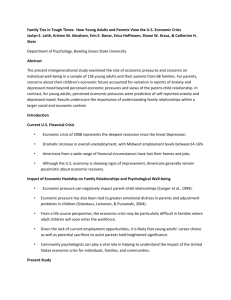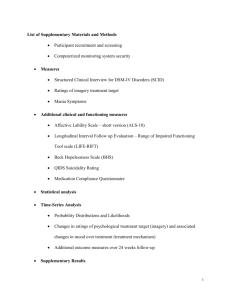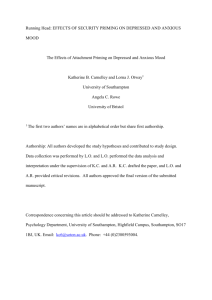somatisation - reattribution model summarised
advertisement
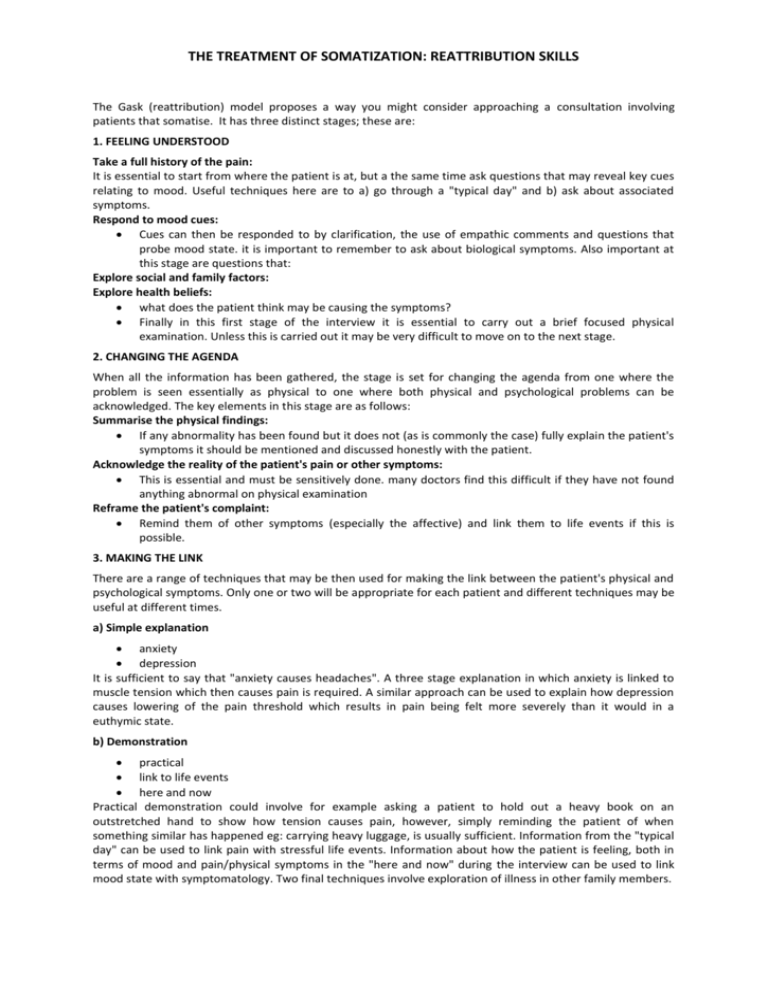
THE TREATMENT OF SOMATIZATION: REATTRIBUTION SKILLS The Gask (reattribution) model proposes a way you might consider approaching a consultation involving patients that somatise. It has three distinct stages; these are: 1. FEELING UNDERSTOOD Take a full history of the pain: It is essential to start from where the patient is at, but a the same time ask questions that may reveal key cues relating to mood. Useful techniques here are to a) go through a "typical day" and b) ask about associated symptoms. Respond to mood cues: Cues can then be responded to by clarification, the use of empathic comments and questions that probe mood state. it is important to remember to ask about biological symptoms. Also important at this stage are questions that: Explore social and family factors: Explore health beliefs: what does the patient think may be causing the symptoms? Finally in this first stage of the interview it is essential to carry out a brief focused physical examination. Unless this is carried out it may be very difficult to move on to the next stage. 2. CHANGING THE AGENDA When all the information has been gathered, the stage is set for changing the agenda from one where the problem is seen essentially as physical to one where both physical and psychological problems can be acknowledged. The key elements in this stage are as follows: Summarise the physical findings: If any abnormality has been found but it does not (as is commonly the case) fully explain the patient's symptoms it should be mentioned and discussed honestly with the patient. Acknowledge the reality of the patient's pain or other symptoms: This is essential and must be sensitively done. many doctors find this difficult if they have not found anything abnormal on physical examination Reframe the patient's complaint: Remind them of other symptoms (especially the affective) and link them to life events if this is possible. 3. MAKING THE LINK There are a range of techniques that may be then used for making the link between the patient's physical and psychological symptoms. Only one or two will be appropriate for each patient and different techniques may be useful at different times. a) Simple explanation anxiety depression It is sufficient to say that "anxiety causes headaches". A three stage explanation in which anxiety is linked to muscle tension which then causes pain is required. A similar approach can be used to explain how depression causes lowering of the pain threshold which results in pain being felt more severely than it would in a euthymic state. b) Demonstration practical link to life events here and now Practical demonstration could involve for example asking a patient to hold out a heavy book on an outstretched hand to show how tension causes pain, however, simply reminding the patient of when something similar has happened eg: carrying heavy luggage, is usually sufficient. Information from the "typical day" can be used to link pain with stressful life events. Information about how the patient is feeling, both in terms of mood and pain/physical symptoms in the "here and now" during the interview can be used to link mood state with symptomatology. Two final techniques involve exploration of illness in other family members. THE TREATMENT OF SOMATIZATION: REATTRIBUTION SKILLS c) Identification family member Other members of a patient's family may have experienced similar symptoms at the time of life threatening illness and the significance of the present symptoms can be explored in terms of their "special meaning" to the patient. d) Projection family member It is often easier to understand psychological mechanisms which occur in others and if other members of the patient's family have experienced physical symptoms when clearly under stress, the significance of this link may be used to draw helpful parallels with their own situation. Clearly this is not a totally comprehensive model as further techniques are now required to help in the management of the symptoms themselves eg: cognitive techniques to cope with pain, anxiety management etc. SKILLS NEEDED TO DO THE ABOVE THREE STAGES: DETECTION SKILLS Patients come with problems, not diagnoses. Beginning the interview. NB: Verbal cues. Nonverbal cues. Open questions "tell me more about..." "take me through a typical day" Clarification "tell me what you mean by..." "...stress" Asking for an example. Supportive statements. Health beliefs and concerns "is this a realistic fear?" Empathy. Eye contact. Control. Summarising. The Colombo scam "you tell me...but..." Homework. keywords & affect laden words Sources of information What the patient tells you What you see yourself "you look..." "you sound..." Your feelings MANAGEMENT SKILLS Ventilation of feelings. Negotiation. Making links. Problem solving. Special types of interviewing. THE TREATMENT OF SOMATIZATION: REATTRIBUTION SKILLS Summary: the structure of problem based interviewing Feeling understood 1. 2. 3. 4. 5. 6. 7. Take a full history elicit other associated symptoms ask about a typical pain day Respond to mood cues Clarification empathic comments probe mood state/thought content Explore social and family factors Check for biological symptoms Explore patients health beliefs Carry out focussed physical examination Changing the agenda 1. 2. 3. 4. Feed back results of physical examination Acknowledge reality of pain Reframe the patient's complaint summarise psychological symptoms remind them of mood symptoms and link to life events negotiate: "I wonder if..." Making the link mood/pathogenesis/symptoms 1. Between anxiety and physical symptoms "uptight" and muscle tension 2. Between depression and physical symptoms lowering pain threshold 3. By practical demonstration holding a book carrying heavy luggage 4. To life events link with mood or stressful events 5. In the "here and now" "how are things today/now/at this moment?" 6. With illness in other family members by explaining shared symptoms (identification) by explaining shared illness behaviours (projection)

